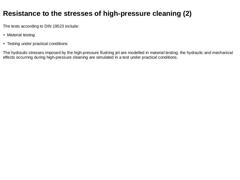
|
The tests according to DIN 19523 include: The hydraulic stresses imposed by the high-pressure flushing jet are modelled in material testing; the hydraulic and mechanical effects occurring during high-pressure cleaning are simulated in a test under practical conditions. |
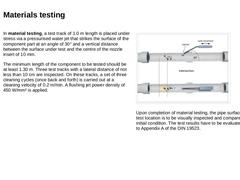
|
In material testing, a test track of 1.0 m length is placed under stress via a pressurised water jet that strikes the surface of the component part at an angle of 30° and a vertical distance between the surface under test and the centre of the nozzle insert of 10 mm. The minimum length of the component to be tested should be at least 1.30 m. Three test tracks with a lateral distance of not less than 10 cm are inspected. On these tracks, a set of three … |
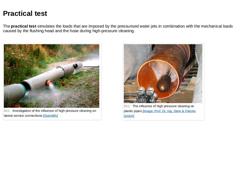
|
The practical test simulates the loads that are imposed by the pressurised water jets in combination with the mechanical loads caused by the flushing head and the hose during high-pressure cleaning. (Image: Investigation of the influence of high pressure cleaning on lateral service connections) (Image: The influence of high pressure cleaning on plastic pipes) |
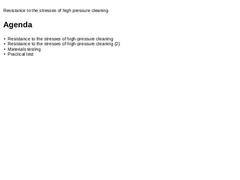
|
|
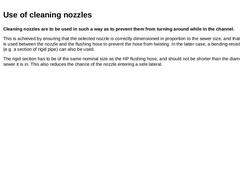
|
Cleaning nozzles are to be used in such a way as to prevent them from turning around while in the channel. This is achieved by ensuring that the selected nozzle is correctly dimensioned in proportion to the sewer size, and that a swivel joint is used between the nozzle and the flushing hose to prevent the hose from twisting. In the latter case, a bending-resistant extension (e.g. a section of rigid pipe) can also be used. The rigid section has to … |
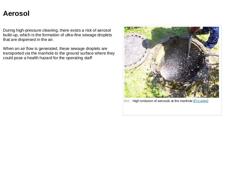
|
During high-pressure cleaning, there exists a risk of aerosol build-up, which is the formation of ultra-fine sewage droplets that are dispersed in the air. When an air flow is generated, these sewage droplets are transported via the manhole to the ground surface where they could pose a health hazard for the operating staff (Image: High emission of aerosols at the manhole) |
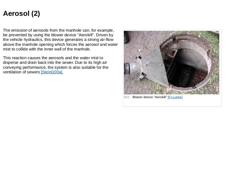
|
The emission of aerosols from the manhole can, for example, be prevented by using the blower device "Aerokill". Driven by the vehicle hydraulics, this device generates a strong air-flow above the manhole opening which forces the aerosol and water mist to collide with the inner wall of the manhole. This reaction causes the aerosols and the water mist to disperse and drain back into the sewer. Due to its high air conveying performance, the system is … |
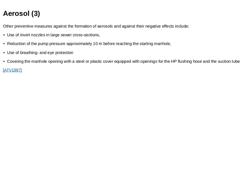
|
Other preventive measures against the formation of aerosols and against their negative effects include: -
Use of invert nozzles in large sewer cross-sections,
-
Reduction of the pump pressure approximately 10 m before reaching the starting manhole,
-
Use of breathing- and eye protection
-
Covering the manhole opening with a steel or plastic cover equipped with openings for the HP flushing hose and the suction tube.
[ATV1997] |

|
|
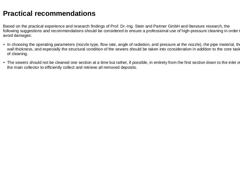
|
Based on the practical experience and research findings of Prof. Dr.-Ing. Stein and Partner GmbH and literature research, the following suggestions and recommendations should be considered to ensure a professional use of high-pressure cleaning in order to avoid damages: -
In choosing the operating parameters (nozzle type, flow rate, angle of radiation, and pressure at the nozzle), the pipe material, the wall thickness, and especially the structural …
|
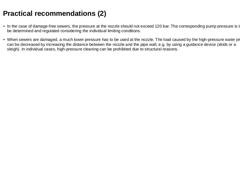
|
-
In the case of damage-free sewers, the pressure at the nozzle should not exceed 120 bar. The corresponding pump pressure is to be determined and regulated considering the individual limiting conditions.
-
When sewers are damaged, a much lower pressure has to be used at the nozzle. The load caused by the high-pressure water jets can be decreased by increasing the distance between the nozzle and the pipe wall, e.g. by using a guidance device (skids …
|
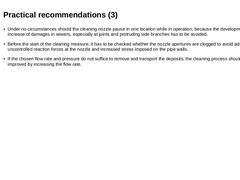
|
-
Under no circumstances should the cleaning nozzle pause in one location while in operation, because the development or increase of damages in sewers, especially at joints and protruding side branches has to be avoided.
-
Before the start of the cleaning measure, it has to be checked whether the nozzle apertures are clogged to avoid additional and uncontrolled reaction forces at the nozzle and increased stress imposed on the pipe walls.
-
If the chosen …
|
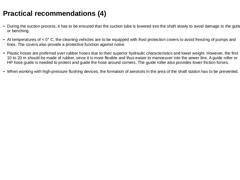
|
-
During the suction process, it has to be ensured that the suction tube is lowered into the shaft slowly to avoid damage to the gutter or benching.
-
At temperatures of < 0° C, the cleaning vehicles are to be equipped with frost protection covers to avoid freezing of pumps and lines. The covers also provide a protective function against noise.
-
Plastic hoses are preferred over rubber hoses due to their superior hydraulic characteristics and lower …
|
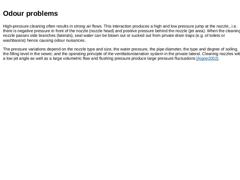
|
High-pressure cleaning often results in strong air flows. This interaction produces a high and low pressure jump at the nozzle., i.e. there is negative pressure in front of the nozzle (nozzle head) and positive pressure behind the nozzle (jet area). When the cleaning nozzle passes side branches (laterals), seal water can be blown out or sucked out from private drain traps (e.g. of toilets or washbasins) hence causing odour nuisances. The pressure … |

|
The following measures can reduce the occurrence of odours: -
Reduction of the pump pressure at the vehicle (resulting in a lower flushing pressure)
-
Choosing the appropriate cleaning nozzle (large jet angles, low number of nozzle inserts)
-
Reduction of the pullback velocity of the nozzle
-
Cleaning of preferably short sections from manhole to manhole
-
Regular removal of waste material within a section
-
Improvement of the aeration (air inlet and outlet), …
|
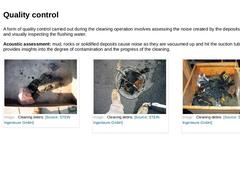
|
A form of quality control carried out during the cleaning operation involves assessing the noise created by the deposits during suction and visually inspecting the flushing water. Acoustic assessment: mud, rocks or solidified deposits cause noise as they are vacuumed up and hit the suction tube. This provides insights into the degree of contamination and the progress of the cleaning. |
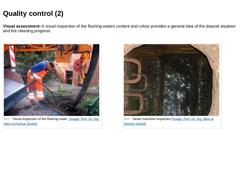
|
Visual assessment: A visual inspection of the flushing waters content and colour provides a general idea of the deposit situation and the cleaning progress. (Image: Visual inspection of the flushing water) (Image: Sewer manhole inspection) |
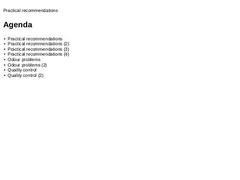
|
|
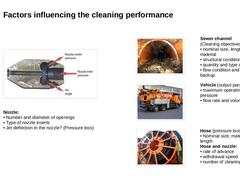
|
(Image: Selection of the nozzle and the jet angle) Nozzle: • Number and diameter of openings
• Type of nozzle inserts
• Jet deflection in the nozzle? (Pressure loss) (Image: Deposits sewer - mixtures of organic and mineral substances) Sewer channel
(Cleaning objectives): • nominal size, length, depth material
• structural condition
• quantity and type of deposits
• flow condition and level of backup. (Image: Combined high pressure flushing and suction … |
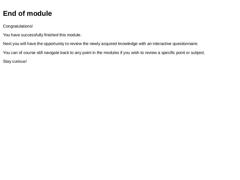
|
Congratulations! You have successfully finished this module. Next you will have the opportunity to review the newly acquired knowledge with an interactive questionnaire. You can of course still navigate back to any point in the modules if you wish to review a specific point or subject. Stay curious! |
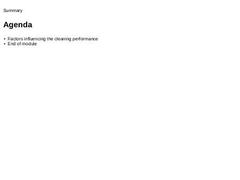
|
|
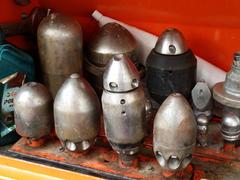
|
An essential part of high-pressure cleaning are the cleaning nozzles. This module covers the complex task of choosing the optimal cleaning nozzle for the respective application, as there are a multitude of nozzle types with different features available. After completing this module, you will have a sound knowledge of: - the physical mode of action of pressurized water jets;
- selection of cleaning nozzles depending on the cleaning task and
- assessment and recognition of application risks.
|
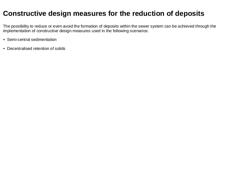
|
The possibility to reduce or even avoid the formation of deposits within the sewer system can be achieved through the implementation of constructive design measures used in the following scenarios: |
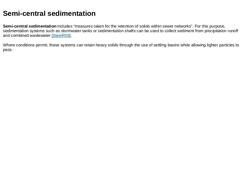
|
Semi-central sedimentation includes “measures taken for the retention of solids within sewer networks”. For this purpose, sedimentation systems such as stormwater tanks or sedimentation shafts can be used to collect sediment from precipitation runoff and combined wastewater [SteinR08].
Where conditions permit, these systems can retain heavy solids through the use of settling basins while allowing lighter particles to pass.
|
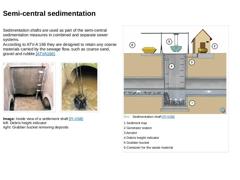
|
Sedimentation shafts are used as part of the semi-central sedimentation measures in combined and separate sewer systems.
According to ATV-A 166 they are designed to retain any coarse materials carried by the sewage flow, such as coarse sand, gravel and rubble [ATVA166]. (Image: Sedimentation shaft) (Image: Sedimentation shaft - Grabber bucket) Image: Inside view of a settlement shaft [FI-VSB]
left: Debris height indicator
right: Grabber bucket removing … |